#jaggery
Text

Cranberry chutney
Sweet, tart, jammy cranberries evolve into the subtle aromatics of cumin, mustard, and bay leaf before rounding off into a smooth, even chili heat in this Anglo-Indian-style chutney. It's excellent in place of cranberry sauce on all kinds of roasts, meat pies, flatbreads, sandwiches, and charcuterie boards.
The cooked fruit-and-vinegar chutneys made by English cooks during the British colonization of India were inspired by the fresh and pickled Indian condiments that English traders and soldiers—including those in the East India Company's military arm—had acquired a taste for, but substituted locally familiar produce and cooking methods for Indian ones. "Indian" recipes began appearing in English cookbooks in the mid-18th century, inspiring and fulfilling a desire for the exotic and, effectively, advertising colonial goods. The domestic kitchen thus became a productive site for the creation and negotiation of colonial ideology: the average English housekeeper could feel a sense of ownership over India and its cultural and material products, and a sense of connection to the colonial endeavor desite physical distance.
This sauce, centered around a tart fruit that is simmered with sugar and savory aromatics and spices, is similar in composition to an Anglo-Indian chutney, but some Indian pantry staples that British recipes tend to substitute or remove (such as jaggery, bay leaf, and mustard oil) have been imported back in. The result is a pungent, spicy, deeply sweet, slightly sour topping that's good at cutting through rich, fatty, or starchy foods.
Recipe under the cut!
Patreon | Tip jar
Ingredients:
1/2 cup dried cranberries (krainaberee), or 1 cup fresh or frozen
5 curry leaves (kari patta), or 1 Indian bay leaf (tej patta)
1/2 tsp cumin seeds (jeera)
1/2 tsp black mustard seeds (rai)
3 Tbsp jaggery (gur / gud)
1-3 small red chili peppers (kali mirch), to taste
1/2” chunk (5g) ginger (adarakh), peeled
1 clove garlic (lahsun)
1/2 red onion (pyaaj) or 1 shallot
1 Tbsp mustard oil (sarson ke tel)
1/3 cup (80 mL) water
Pinch black salt (kala namak)
Curry leaves can be purchased fresh at a South Asian grocery store. If you can't find any, Indian bay leaves can be used as a substitute (the flavor isn't per se similar, but it would also be appropriate in this dish). Indian bay leaves are distinct from Turkish or California laurel bay leaves and have a different taste and fragrance. They will be labelled “tej patta” in an Asian or halaal grocery store, and have three vertical lines running along them from root to tip, rather than radiating out diagonally from a central vein.
Instructions:
1. Pound onion, garlic, ginger, and chili to a paste in a mortar and pestle; or, use a food processor.
2. In a thick-bottomed pot, heat mustard oil on medium. Add curry leaves or tej patta and fry until fragrant.
3. Add cumin and mustard seed and fry another 30 seconds to a minute, until fragrant and popping.
4. Lower heat to low. Add aromatic paste and fry, stirring constantly, for about 30 seconds, until fragrant.
5. Add cranberries, jaggery, black salt, and water. Raise heat and bring to a boil. Reduce to a simmer and cook uncovered, stirring often, until thick and jammy. Remove from heat a bit before it reaches your desired consistency, since it will continue to thicken as it cools.
Store in a jar in the refrigerator for 2-3 weeks.
#Anglo Indian#fusion#Christmas#cranberries#dried cranberries#curry leaves#tej patta#mustard oil#jaggery#cooking#gluten free#condiments#Indian
147 notes
·
View notes
Text
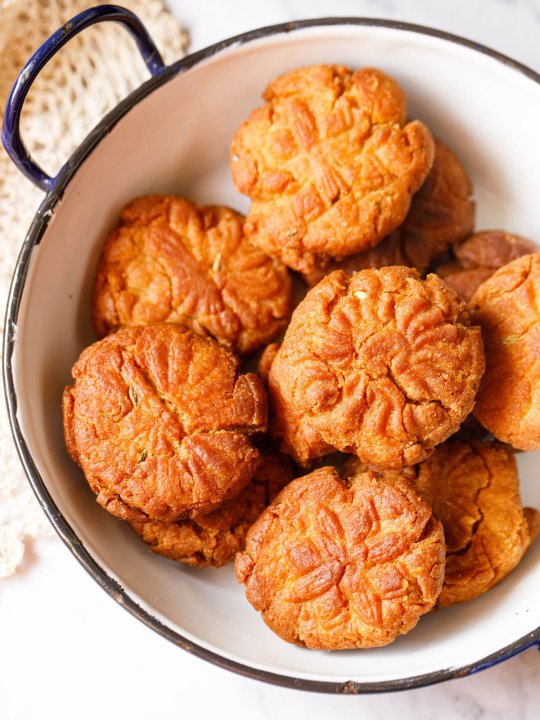
Thekua
45 notes
·
View notes
Text
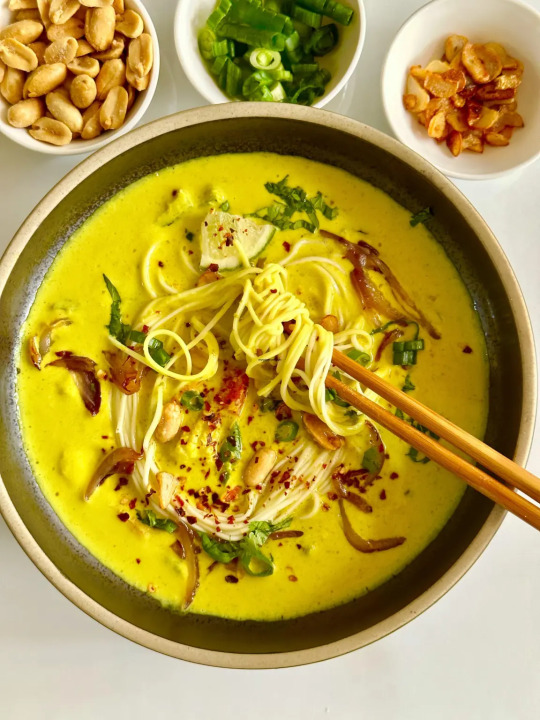
Vegan Burmese Khao Suey
#vegan#lunch#dinner#burmese cuisine#southeast asian cuisine#noodle bowl#curries#khao suey#lemongrass#carrots#baby corn#green beans#bell peppers#turmeric#garlic#ginger#chili#cilantro#coconut milk#olive oil#curry leaves#lime#jaggery#peanuts#lemon#noodles#💛
117 notes
·
View notes
Photo

Puran Poli
#puran poli#indian#flatbread#recipe#jaggery#lentils#dal#cardamom#spice#asian#bread#chana dal#saffron#whole wheat#atta#myfoodstory
168 notes
·
View notes
Text
About jaggery...
Okay so, random post: I love panela, also known as gur, jaggery and a million other names across both latin america and asia.
Why is that? Well, there are multiple reasons, first of which is that it's fucking awesome.
Like, you're telling me that there's this pill paste thing that's made of fucking sugarcane juice, is sweet asf while not being as harmful to your health? Count me in! Plus, it's literally so good, you can make coffee with it, or the most banger hot chocolate you've ever had, or even fucking lemonade which tastes amazing!
There's also the process, it's literally just soakig, boiling, molding and then drying sugarcane! And nothing is lost in the process! The paste thingy is the jaggery itself, the remaining juices, also called melaza, is used as a sweetener that even people with diabetes can use cuz it's 100% natural and also animal supplement (yeah, you heard me right! Animal supplement!), and the sugarcane fiber goes into the furnace as fuel! Nothing is wasted!.
On top of that, it's a point of connection across continents, it's common in both latin america and some parts of asia! It's so cool that we had the same idea even being an ocean apart, and if it's something that the indias brought here or something, then that's just to show that it's become such a staple in the culture over here that it's ingrained in the very soul of the subcontinent! (Like, literally the two biggest producers and consumers of jaggery in the world are India and Colombia, an asian and a latin american country)
It feels like we're connected, even across an ocean and half a continent, even across the centuries, millenia even, of history, we still have the same tastes.
Also, spice buddies! We grow spices and get colonized for it! We're practically cousins!
Sending good vibes to all my desi and latino mates wherever you are, we're all together in this to some degree
#420
6 notes
·
View notes
Text

Prawn Patia
2 Tbsp. vegetable oil
10 curry leaves
1 small onion, finely chopped (about 1 cup)
2 small green chilis (such as Thai bird) chopped fine
½ cup tomato purée
1 Tbsp. ginger garlic paste
1½ tsp. red chili powder (cayenne powder)
½ tsp. turmeric powder
1 tsp. cumin powder
½ tsp. granulated sugar or grated jaggery
1½ Tbsp. vinegar (preferably palm vinegar)
2 Tbsp. water
kosher salt
1 cup medium shelled, deveined shrimp
1 Tbsp. chopped cilantro leaves
Heat oil in a large skillet over medium-high heat until shimmering. Gently put in the curry leaves and step aside as they pop. Stir for 20 seconds. Add the chopped onions and stir until lightly browned, about 5 minutes. Add the green chilies and stir for another minute. Add the tomato puree and keep stirring until oil separates from the onion tomato mix, about 5 minutes. Add the ginger-garlic past, red chili, turmeric, and cumin, and keep stirring until mixture is fragrant, about 5 minutes, taking care to ensure the mixture doesn't stick to the bottom.
Add the sugar/grated jaggery, vinegar, and water and cook till the rawness of the tomato is gone, about 5 minutes. Season to taste with salt. Add the shrimp, stir and let cook for one minute. Remove from heat. Allow to continue cooking off heat, stirring occasionally, until shrimp are cooked through, about 4 minutes longer. Garnish with coriander and serve with white rice and daal.
#angelkin#food#dinner#dairy free#gluten free#pescatarian#curry leaf#vegetable#onion#pepper#tomato#ginger#garlic#cayenne pepper#turmeric#cumin#jaggery#vinegar#seafood#shrimp#cilantro#dragonkin#mountainkin#pantherkin#pheonixkin#winter
3 notes
·
View notes
Text
Benefits of Jaggery Tea
Jaggery tea, a traditional beverage made from natural sweetener jaggery, has been gaining popularity for its numerous health benefits. When compared to regular sugar, jaggery offers a range of advantages that make it a healthier alternative.
One of the key benefits of jaggery tea is its impact on blood sugar levels. Unlike refined sugar, which causes rapid spikes and crashes in blood glucose levels, jaggery has a lower glycemic index. This means that it is digested and absorbed more slowly by the body, resulting in a more gradujaggery tea is rich in essential minerals such as iron and magnesium. Iron plays a crucial role in maintaining healthy red blood cells and preventing anemia, while magnesium supports proper nerve function and helps regulate blood pressure.
Moreover, jaggery contains antioxidants that help combat free radicals in the body. These antioxidants can contribute to overall well-being by reducing oxidative stress and supporting a healthy immune system.
Another advantage of choosing jaggery over regular sugar is its natural sweetness combined with its distinct flavor profile. Jaggery imparts a unique caramel-like taste to beverages like tea, adding depth and complexity to each sip without the need for artificial additives or flavorings. You can try Jaggery tea https://foodiajaggerytea.com/ here.
In summary, opting for jaggery tea instead of sugar brings several health benefits to the table. From stabilizing blood sugar levels to providing essential minerals and antioxidants, this natural sweetener proves to be an excellent choice for those looking to enhance their well-being while enjoying their favorite be
2 notes
·
View notes
Text

Jaggery Lemon Sarbat 🍹
7 notes
·
View notes
Text
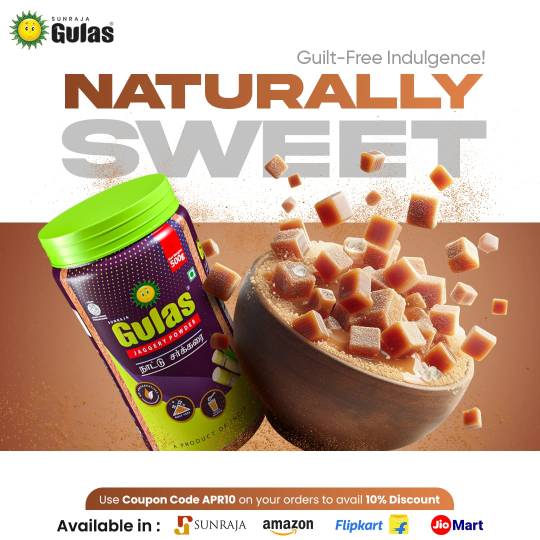
Gulas jaggery Powder 100% dust free pure jaggery Powder with no added additives and preservatives.
Order now. Use coupon APR10 to avail 10% discount. Shopping links are in Bio
#gulas#SugarReplacement#jaggery#jaggerypowder#cookies#sunraja#mrgoldoils#brownsugar#sunrajagulas#amlacandy#SunrajaGulas#naturalsweetner
0 notes
Text
Unveiling the Sweet Treasure: Exploring the Magic of Jaggery
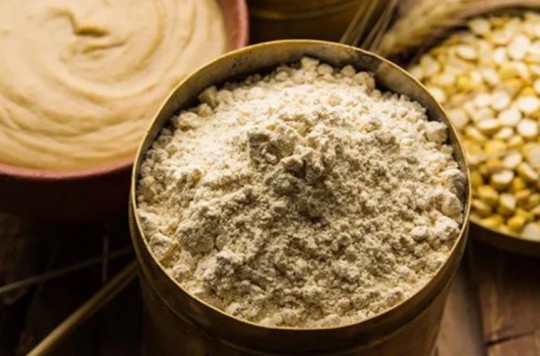
Introduction:
Jaggery, often dubbed as nature's sweetener, has been a beloved ingredient in kitchens across cultures for centuries. Derived from the sap of sugarcane or palm trees, jaggery boasts not only a rich, caramel-like flavor but also a plethora of health benefits. In this enlightening journey, we delve into the world of jaggery, uncovering its origins, nutritional properties, culinary uses, and the timeless allure behind this wholesome sweetener.
The Essence of Jaggery:
Tracing the Origins of Jaggery
Jaggery, known by various names such as gur, panela, or vellam, has a rich history steeped in tradition and cultural significance. Its origins can be traced back to ancient civilizations where it was prized for its natural sweetness and medicinal properties. In India, jaggery holds a revered place in Ayurveda, the ancient system of medicine, where it is valued for its holistic healing properties and as an essential ingredient in various remedies and tonics.
The Craft of Jaggery Making
The process of making jaggery is a time-honored tradition that involves boiling the sap of sugarcane or palm trees until it thickens and solidifies into a dense, unrefined sugar. Unlike refined sugar, which undergoes extensive processing and chemical treatments, jaggery retains its natural nutrients, including vitamins, minerals, and antioxidants. This traditional method of jaggery production not only preserves its nutritional integrity but also imparts a distinct flavor and aroma that sets it apart from other sweeteners.
Nutritional Benefits of Jaggery:
Nature's Nutrient Powerhouse
Jaggery is not just a source of sweetness but also a nutritional powerhouse packed with essential vitamins and minerals. It contains significant amounts of iron, potassium, magnesium, and calcium, along with vitamins A, B, and C. Its high iron content makes it especially beneficial for individuals with iron deficiency or anemia, while its potassium content supports heart health and regulates blood pressure. Moreover, the presence of antioxidants in jaggery helps neutralize free radicals and protect against oxidative stress, contributing to overall well-being.
Balancing Energy and Digestion
In Ayurveda, jaggery is revered for its ability to balance the doshas, or bodily energies, particularly Vata and Pitta. Its sweet taste and grounding properties help pacify Vata dosha, which governs movement and creativity, while its cooling nature soothes Pitta dosha, responsible for digestion and metabolism. Consuming jaggery in moderation can help regulate energy levels, promote digestion, and alleviate symptoms of digestive disorders such as acidity, bloating, and constipation.
Culinary Uses of Jaggery:
From Traditional Sweets to Savory Delicacies
Jaggery's versatility in the kitchen knows no bounds. In Indian cuisine, it is used to sweeten a wide array of traditional sweets and desserts, including ladoos, halwas, payasams, and chikkis. Its rich, caramel-like flavor adds depth and complexity to these indulgent treats, making them irresistible to the palate. Moreover, jaggery finds its way into savory dishes as well, where it is used to balance out spicy, tangy, and savory flavors in dishes like chutneys, sauces, and marinades.
Exploring Jaggery Varieties:
Diverse Flavors and Aromas
While sugarcane jaggery is the most common variety, jaggery can also be made from other sources such as palm sap, date palm, or coconut palm. Each variety of jaggery boasts its own unique flavor profile, aroma, and color, reflecting the local terrain, climate, and cultural traditions. Exploring these diverse jaggery varieties not only adds depth to culinary creations but also offers a glimpse into the rich tapestry of flavors and aromas found in different regions.
Conclusion:
In conclusion, jaggery stands as a testament to the timeless wisdom of traditional food practices and the bountiful gifts of nature. Its rich flavor, nutritional benefits, and versatile culinary uses make it a cherished ingredient in kitchens around the world. As we celebrate the sweetness of jaggery, let us embrace its wholesome goodness and honor the ancient traditions that have sustained generations of health and vitality.
FAQs:
Q1: Is jaggery healthier than refined sugar?
A1: Yes, jaggery is considered healthier than refined sugar as it retains more vitamins and minerals due to minimal processing. Additionally, jaggery has a lower glycemic index compared to refined sugar, resulting in slower blood sugar spikes and a more sustained energy release.
Q2: Can jaggery be used as a substitute for sugar in recipes?
A2: Yes, jaggery can be used as a substitute for sugar in most recipes, including desserts, beverages, and savory dishes. However, keep in mind that jaggery has a distinct flavor that may alter the taste of the final dish, so it's best to adjust the quantity according to your preference.
Q3: Is jaggery suitable for individuals with diabetes?
A3: While jaggery is often touted as a healthier alternative to refined sugar, it still contains sucrose and should be consumed in moderation by individuals with diabetes. It's advisable to consult a healthcare professional to determine the appropriate amount of jaggery to include in your diet.
Further Reading:
10 Amazing Health Benefits of Jaggery - Rural Treasures
0 notes
Text
#weight loss#ketocommunity#ketojourney#ketoweightloss#ketofriendly#ketomeals#ketosnacks#ketolife#ketorecipes#ketofood#jaggery
0 notes
Text
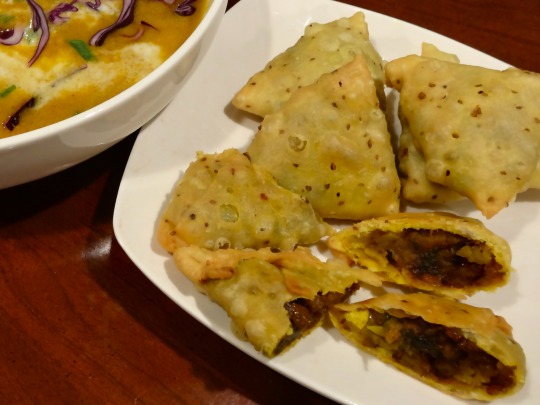
[ID: Several small, triangular samosas piled on a plate. Their skins are studded with small brown seeds. Two of the samosas are cut open to show their deep brown filling. End ID.]
Samusa / စမူဆာ (Burmese samosas)
Burmese samusa are smaller than Indian samosas, and their fillings tend to have a different spice profile. This recipe for potato samusa features a filling flavored with turmeric and black mustard seed and made richly sweet with the addition of jaggery—a tamarind dipping sauce adds tartness, saltiness, and umami. Leftover samusa are also excellent in samusa thouk—a brightly savory soup commonly made with split chickpeas and tamarind.
Recipe under the cut!
Patreon | Tip jar
Makes 8.
INGREDIENTS:
For the dough:
1/2 cup (60g) all-purpose flour
1/4 tsp salt
1/2 tsp carom seeds (ajwain)
1 Tbsp vegetable oil
About 2 Tbsp water
For the filling:
1 1/3 cup minced potato (1 large, 160g)--or boiled and mashed
1/2 small yellow onion, minced (2 Tbsp)
1 large jalapeño, minced (2 Tbsp)
15 mint leaves, minced
2 1/2 tsp turmeric
2 tsp ground Kashmiri chili (mirchi), or to taste*
2-4 tsp jaggery or brown sugar
1 1/2 tsp carom seeds (ajwain), toasted and ground
3/4 tsp brown mustard seeds (rai), toasted and ground
1 tsp cornstarch (optional)**
2 Tbsp neutral oil
*Mirchi consists of dried ground red chili peppers and is different from chili powder, which contains additional spices. If you don't have any, you may use another type of ground red chiil (prik bon, gochugaru, cayenne pepper) or grind dried red chilis yourself in a spice grinder or mortar and pestle.
**The cornstarch helps the filling stay compact and non-soggy. I have, however, omitted it before without anything terrible happening.
For the dipping sauce:
2 Tbsp tamarind paste*
1 Tbsp vegan fish sauce (such as Au Lac)**
1 Tbsp soy sauce
1 Tbsp jaggery or brown sugar
1/2" chunk (5g) ginger, grated
2 cloves garlic, grated
3-4 Thai bird's eye chili peppers, minced
*You may also use tamarind pulp, soaked in warm water for about 20 minutes and then mashed into a paste.
**Fish sauce tastes fermented and salty, not necessarily like fish. If you don't have a vegetarian fish sauce imitation on hand, you may use any fermented soybean product (fermented bean curd, doenjang, miso paste, light soy sauce) plus 1/4 tsp of salt.
To fry:
Several cups of a neutral oil
INSTRUCTIONS:
For the dough:
1. If measuring by weight, spoon flour gently into a dry measuring cup and then level off. In a small mixing bowl, add all dough ingredients except water and mix until well-combined.
2. Add water 1/2 Tbsp at a time until a smooth, slightly tacky dough forms. It should not crumble or form lines at the edges when formed into a ball and pressed flat.
3. Allow dough to rest for 20 minutes while you prepare the filling.
For the filling:
1. If using whole spices, toast carom and mustard seeds in a dry skillet over medium heat for a few minutes until fragrant. Grind using a spice grinder or mortar and pestle.
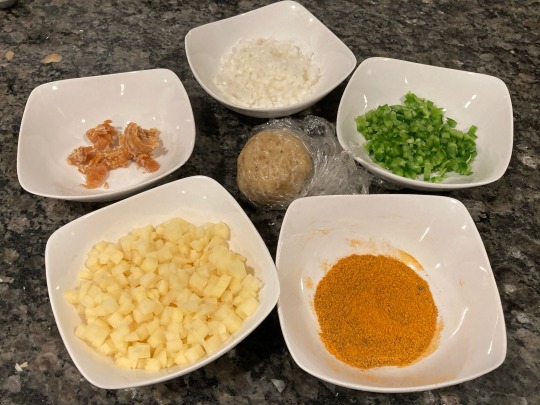
2. Heat 2 Tbsp of a neutral oil on medium in a skillet. Add onion and fry for a few minutes until translucent.
3. Add ground spices (carom seeds, mustard seeds, turmeric, chili) and allow to bloom in the oil for 30 seconds.
4. Add jalapeño and fry for a minute or two.
5. Add minced potato and salt and fry on low until tender. If potatoes are still not tender and seem dry, add a teaspoon of water and cover to steam until they are soft. (If you are using mashed potato, just add it to the pan.)
6. Add mint and jaggery and cook, stirring constantly, until jaggery dissolves. Set aside and stir in cornstarch.
For the dipping sauce:
1. In a small bowl, whisk all ingredients together.
To assemble:
1. Divide your dough into four equal sections (each of mine weighed about 24 grams)--each of these will make four samusa. Divide the filling into eight equal portions. Take one ball and cover the dough that you are not working with.
2. On a lightly floured surface, roll out the ball of dough into a circle about 6" (15cm) in width, or about as large as you can make it--the dough should be translucent in places. You can do this by rolling out from the center to the edge, then rotating the rolling pin and repeating the motion, until you have gone all the way around the circle.
The carom seeds may form small holes around themselves as you roll out the dough--this is normal and these will close again as you shape the samusa.
3. Using a sharp knife, cut the dough circle in half. Set one half aside and cover it to avoid drying out. Place one portion of filling in the center of your piece of dough. Optionally, wet the edges of the dough to make sealing easier.
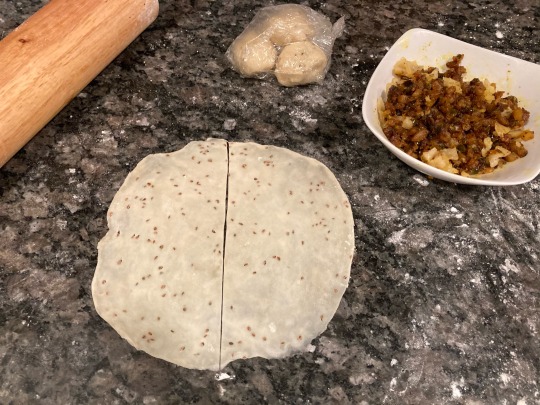

4. Fold one of the triangular sides of your piece of dough (in my pictures, this is the one at the top) over the filling. Repeat on the other side, overlapping the first piece of dough slightly, to cover the filling and create a triangular point on the bottom edge (on the left, in my picture). Press to seal.
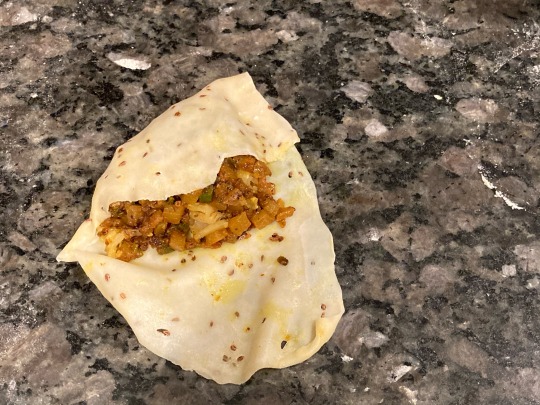

5. Fold the still-open edge back over the samusa to seal in the filling completely and create a triangular shape.


If you are inexperienced with rolling out dough, you may not be able to get the dough thin enough to fold over a whole portion of filling--if so, just reduce the amount of filling in each samusa. If you're not confident that your samusa are fully sealed, you may (instead of deep-frying) pan-fry them in 1/2" (1 cm) of neutral oil, turning once, until both sides are golden brown.
To fry:
1. Fill a small pot with a few inches of oil and heat it to 350 °F (175 °C). A piece of bread dropped into the oil should slowly begin to form bubbles--if it browns and floats immediately, your oil is too hot.
2. Using a slotted spoon, gently lower samusa into the oil. Depending on the size of your pot, you may need to do this in batches--try not to cover more than half of the surface area of the oil, to avoid temperature fluctuations.
3. Fry, flipping occasionally, until golden brown on all sides. Set aside on a wire cooling rack or a paper-towel-lined plate.
4. Optionally, to produce very crispy samusa, fry them again at 370 °F (188 °C). If you want to save some of the samusa to eat later, fry them once and freeze; immediately before serving, fry again.
Serve immediately with dipping sauce. Leftover samusa are sometimes eaten with samusa soup.
45 notes
·
View notes
Text

Made from the freshly condensed product of date palm tree and cane sugar, Karupatti, also known as Palm Jaggery, is a delightful feast for the senses.
Since no chemicals are used in the production of palm jaggery, all of the natural minerals are preserved without the need for preservatives. Karupatti has so demonstrated a number of health advantages.
Know more about best authentic south indian dishes here- https://oorukadai.com/.
#karupatti#palmjaggery#healthyfood#tamil#jaggery#palmsunday#panamkalkandu#palmtree#palmtrees#homemade#southindianfood#indianfood#savepalmtress#socialawareness#cookwithcomali#savetress#goodhealth
0 notes
Text
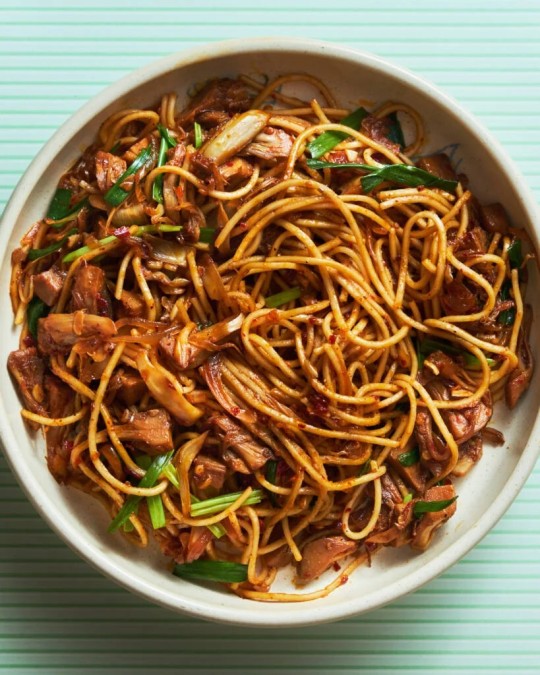
Chili Garlic Jackfruit Noodles (Vegan)
#vegan#lunch#dinner#noodle bowl#noodles#jackfruit#garlic#chili#onion#apple cider vinegar#soy sauce#green onion#jaggery#sesame oil#black pepper#sea salt
20 notes
·
View notes
Text
Sweet Kuzhipaniyaram with leftover dosai batter
Heavenly Sweet Kuzhipaniyaram Recipe: A Delicious Twist on Leftover Dosai BatterLooking for a delightful way to repurpose your leftover dosai batter? Look no further! Our Sweet Kuzhipaniyaram recipe is a perfect blend of tradition and innovation, combining the goodness of jaggery, coconut, banana, and a variety of seeds fried to crispy perfection in ghee. These little spongy treats are sure to…
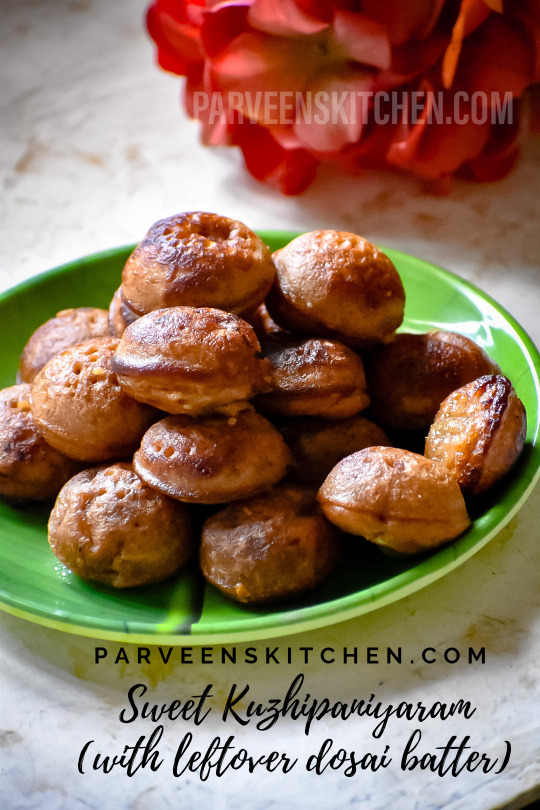
View On WordPress
#Banana Chunks#breakfast#Crispy#delicious#dessert#ghee#Grated coconut#Indian recipes#Jaggery#leftover dosai batter#Pumpkin Seeds#Raisins#Recipe#Sesame seeds#Snack.#Spongy#Sunflower Seeds#sweet Kuzhipaniyaram
0 notes
Text
Health Benefits of Organic Gud: Nature's Sweet Secret Unleashed
In a world where the pursuit of health and wellness has become increasingly paramount, the quest for natural alternatives to refined sugars and artificial sweeteners has intensified.
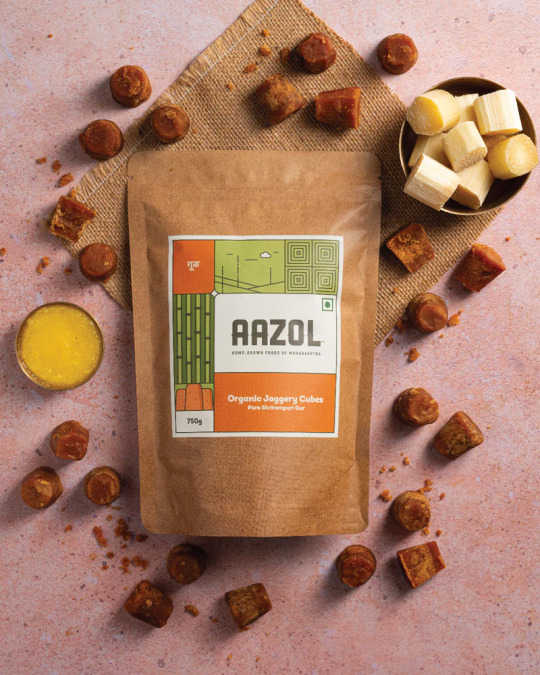
Enter organic gud, a traditional sweetener with a rich history and a myriad of health benefits. Derived from the sap of sugarcane or date palm trees, gud, also known as jaggery, has been a staple in cuisines across India and South Asia for centuries. Yet, its virtues extend far beyond its delightful taste, making it a true superfood worthy of recognition and reverence. In this comprehensive guide, we'll unravel the mysteries of organic gud and unveil its profound impact on our health and well-being.
A Sweet Journey Through Time: The Origins of Organic Gud
The story of organic gud dates back thousands of years, intertwined with the cultural fabric and culinary traditions of ancient civilizations. From the fertile plains of the Indian subcontinent to the sun-drenched groves of the Middle East, the art of extracting sweetness from nature's bounty has been perfected over generations. The process of making gud involves collecting the raw sap from sugarcane or date palm trees and slowly simmering it to remove impurities and moisture, resulting in a thick, caramel-like syrup that solidifies into blocks or cones. This artisanal method preserves the natural goodness of the sap, imbuing gud with a rich spectrum of nutrients and flavors unparalleled by its processed counterparts.
The Nutritional Treasure Trove: Unveiling the Health Benefits of Organic Gud
At the heart of organic gud lies a treasure trove of nutrients, each contributing to its remarkable health benefits. Unlike refined sugar, which undergoes extensive processing, stripping it of its inherent vitamins and minerals, organic gud retains its nutritional integrity, making it a wholesome and nourishing sweetener.
Embracing Nature's Sweet Secret: Incorporating Organic Gud Into Your Lifestyle
Now that we've uncovered the myriad health benefits of organic gud, the next step is to embrace this sweet secret and integrate it into our daily lives.
The Sustainable Choice: Supporting Organic Agriculture and Environmental Stewardship
In addition to its health benefits, choosing organic gud is also an environmentally conscious decision that supports sustainable agriculture and environmental stewardship. Organic farming practices prioritize soil health, biodiversity, and ecosystem resilience, minimizing the use of synthetic pesticides and fertilizers that harm the environment and endanger wildlife. By opting for organic gud, you're not only nourishing your body but also contributing to the preservation of our planet for future generations.
In Conclusion: The Sweet Symphony of Organic Gud
In conclusion, organic gud is more than just a sweetener – it's a symphony of flavors, nutrients, and health benefits that nourish the body, mind, and soul. From its rich nutritional profile to its low glycemic index and immune-boosting properties, gud embodies the essence of holistic health and wellness. By embracing nature's sweet secret and incorporating organic gud into your lifestyle, you're not only enhancing your culinary experiences but also supporting your overall well-being in a sustainable and meaningful way.
So why not indulge in the sweet splendor of organic gud and unlock its full potential? Your taste buds and your body will thank you for it.
0 notes